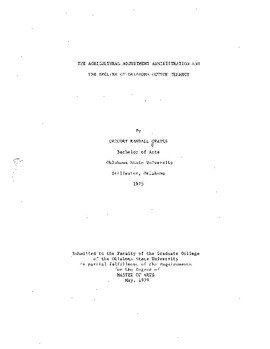| dc.contributor.advisor | Mahnken, Norbert R. | |
| dc.contributor.author | Graves, Gregory Randall | |
| dc.date.accessioned | 2015-09-16T18:21:26Z | |
| dc.date.available | 2015-09-16T18:21:26Z | |
| dc.date.issued | 1979-05-01 | |
| dc.identifier.uri | https://hdl.handle.net/11244/18125 | |
| dc.description.abstract | The Great Depression had a tremendous impact upon the structure of farm tenancy in Oklahoma as well as other agricultural areas of the country. When Franklin Delano Roosevelt and his advisers created the Agricultural Adjustment Administration to aid farmers, its policies resulted in displacement of tenants throughout the Cotton Belt. These early displacements, often popularly attributed to drought conditions, were more directly caused by the provisions of the Cotton Section of the AAA. Both the tenant provisions and the rental payment program greatly reduced the already tenuous position of cotton tenants in Oklahoma and all areas where the share crop and crop lein systems prevailed. In the first year of the AAA its leaders were faced with the fact that crops were already planted and growing. Thus they had to pay farmers to plow under a percentage of the crop in order to reduce overproduction. Tenant farmers were actually aided in 1933, as they participated directly in the program, and shared fully in the benefit payments. However, the following years were not as beneficial. The two-year plan presented to farmers by the Cotton Section of the AAA in 1934 did not allow share tenants and sharecroppers to participate in the program. These tenants, who comprised the majority of cotton tenant farmers, could participate only through their landlord. When landlords were forced to make a choice between sharing benefit payments with these tenants or renting the land to the government, they chose the latter option in most cases and used hired farm labor to farm their holdings. Although AAA officials made some attempts to protect the rights of tenants, their primary concern was to aid the large farmers with whom the success of the plan rested. Thus, the displacements began throughout the Cotton Belt due mainly to the policies of the Agricultural Adjustment Administration. | |
| dc.format | application/pdf | |
| dc.language | en_US | |
| dc.publisher | Oklahoma State University | |
| dc.rights | Copyright is held by the author who has granted the Oklahoma State University Library the non-exclusive right to share this material in its institutional repository. Contact Digital Library Services at lib-dls@okstate.edu or 405-744-9161 for the permission policy on the use, reproduction or distribution of this material. | |
| dc.title | Agricultural Adjustment Administration and the Decline of Oklahoma Cotton Tenancy | |
| dc.type | text | |
| dc.contributor.committeeMember | Bischoff, John Paul | |
| dc.contributor.committeeMember | Rohrs, Richard C. | |
| osu.filename | Thesis-1979-G776a.pdf | |
| osu.accesstype | Open Access | |
| dc.description.department | History | |
| dc.type.genre | Thesis | |
